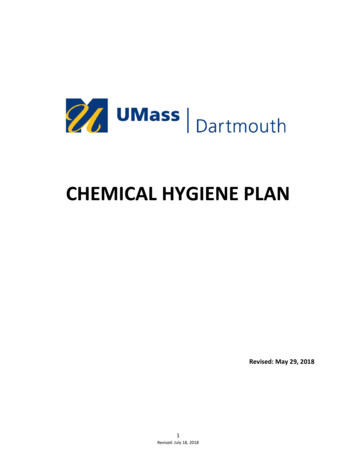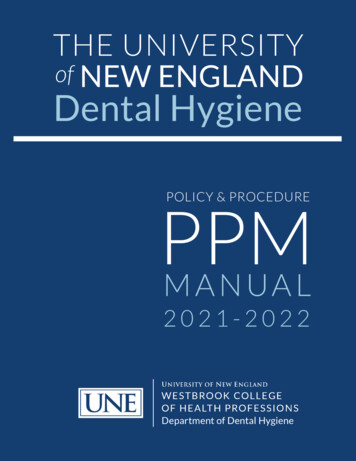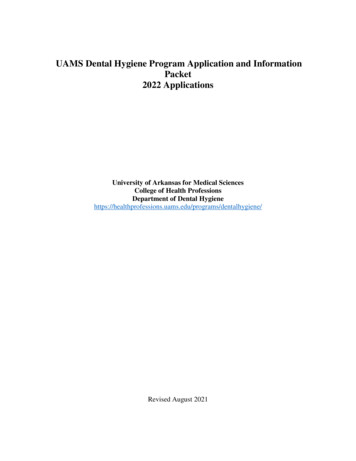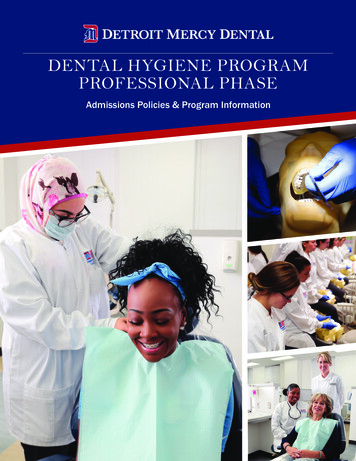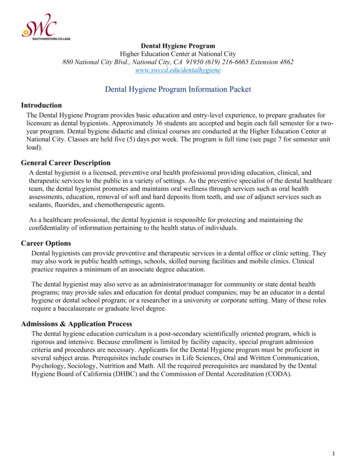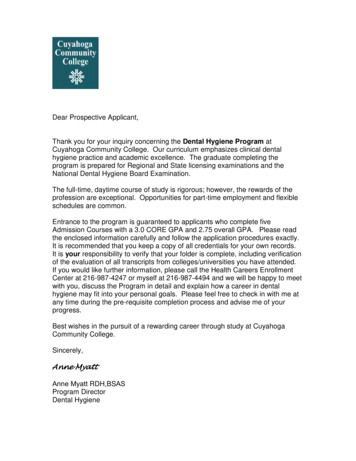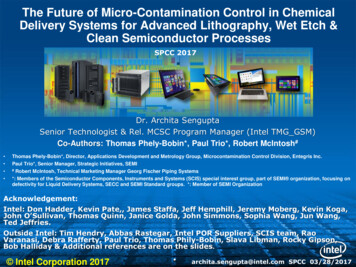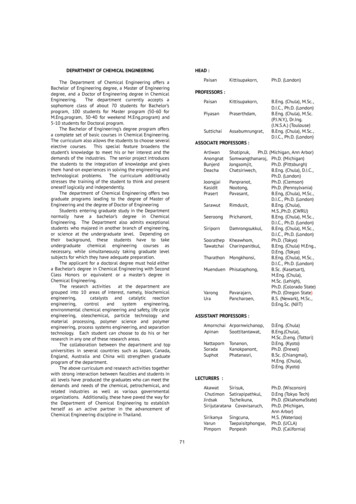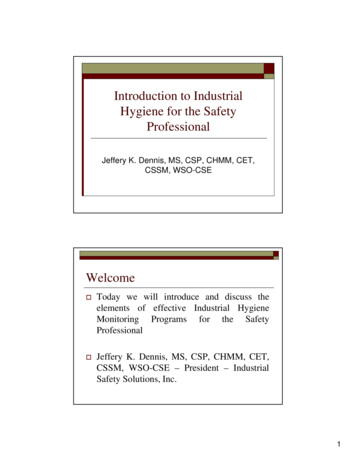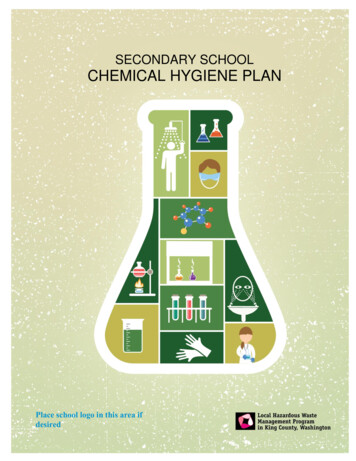
Transcription
SECONDARY SCHOOLCHEMICAL HYGIENE PLANPlace school logo in this area ifdesired
School Name:School Address:Department: Science DepartmentRoom(s) covered by this plan:Administrator responsible for plan implementing:Department Chairperson or Director:Designated IndividualResponsibilityDistrict Chemical Hygiene OfficerHazardous Waste ManagerSchool Hygiene CoordinatorDistrict Safety OfficerImplementation Date:Annual Review Date:Science Department Chair’s Signature:Emergency Telephone NumbersFIRE . . . . . . . . . . . . . . . . . . . . . . . . . . . . . . . . . . .9-911MEDICAL EMERGENCY . . . . . . . . . . . . . . . . . . 9-911SECURITY EMERGENCY . . . . . . . . . . . . . . . . . 9-911POISON CENTER . . . . . . . . . . . . . . . . . . . . . . . . 800-222-1222Alternate formats availablePhone: or TTY relayMade from a template for use by secondary schools in developing site-specific chemical hygiene plans as required byWAC 296-828-2000, Using hazardous chemicals in laboratories, created by the Local Hazardous Waste ManagementProgram in King County, Washington.Chemical Hygiene Plani
School Year:Employees covered by this school’s chemical hygiene plan:1.2.3.4.5.6.7.Note: Occasional visitors to the laboratory, such as a guest or sales person, isn’t defined as anemployee and therefore doesn’t need to be addressed in the Chemical Hygiene Plan.Designated individuals with specific chemical hygiene responsibilities1. Annual inspection of chemical containers:2. Updating the chemical inventory:3. Providing spill response training:4. Hazardous waste disposal:5. Annual fume hood testing:6. Testing eye washes weekly:7. Testing safety showers annually:8. Checking fire extinguishers:9. Maintaining chemical safety data sheets:10. Training new staff in the Hygiene Plan:11. Approval of lab chemical procurement:iiChemical Hygiene Plan
Table of ContentsA. Introduction1. Goal of the Chemical Hygiene Plan2. Who is Covered by the Laboratory Standard3. Summary of the RequirementsB. Chemical Hygiene Personnel1. Goal2. Key Personnel and Their ResponsibilitiesC. Standard Operating Procedures for Laboratories1. Goal2. Online Resources3. Employee Exposure Protection4. Laboratory Facilities Design Criteria5. Employee Exposure Determination and Monitoring6. Medical Consultations and Medical Exams7. Chemical Procurement8. Hazard Identification9. Material Handling10. Laboratory Operations and Activities Requiring Approval11. Emergency Prevention and Response12. Waste Disposal13. Information and Training14. Inspections and Reviewing the Chemical Hygiene PlanD. General Laboratory Safety Rule1. Goal2. General Rules3. Chemical Handling4. Health and Hygiene5. Food Handling6. Housekeeping7. Glassware8. Flammability HazardsE. Specific Exposure Control Measure1. Goal2. Criteria3. Chemicals of special concern4. Exposure Potential5. Exposure Controls6. Decontamination Procedures7. Procedures for Handling Reproductive Toxins8. Procedures for Handling Chemicals with High Acute Toxicity9. Procedures for Handling Select CarcinogensChemical Hygiene Planiii
F. Inspection and Plan Review1. Goal2. Inspection Procedures3. Emergency, First Aid, and Personal Protective Equipment4. Review of the Chemical Hygiene PlanG. Employee Information and Training1. Goal2. Information Requirements3. Employee Training Requirements4. Who Should Be Trained5. Record-Keeping6. Information and Training Frequency7. Information ProgramH. Exposure Monitoring and Medical Attention1. Goal2. Exposure Monitoring3. Medical Attention4. Medical Consultations and Medical ExamAppendix 1. Ban Candidate ChemicalsAppendix 2. Storage Pattern for Chemicals Where Space is LimitedAppendix 3. Science Classroom and Lab Safety Reference and ChecklistAppendix 4. Designated Individuals with Specific Chemical Hygiene ResponsibilitiesAppendix 5. Evaporation Log Sheet for Treating Aqueous Metals SolutionsivChemical Hygiene Plan
A. Introduction1. Goal of the Chemical Hygiene PlanIt is the policy of this school to provide a place of employment that is free from chemicalexposures likely to harm employees’ health, and that complies with all federal, state, and locallaws and regulations affecting the safety and health of its employees. This Chemical HygienePlan addresses this goal for the laboratory workplace by including the requirements of theOccupational Safety and Health Administration (OSHA) Standard on Occupational Exposure ofHazardous Chemicals in Laboratories as adopted into the Washington Industrial Safety andHealth Act (WISHA) (WAC 296-828-200). The Division of Occupational Safety and Health(DOSH) within the Washington State Department of Labor and Industries (L&I) enforcescompliance with the laboratory standard.2. Who is covered by the Laboratory Standard?The laboratory standard covers "laboratory use of hazardous chemicals" where chemicalmanipulations occur that are not part of a production process."Laboratory scale" means work with substances in which the containers used for reactions,transfers, and other handling of substances are designed to be easily and safely manipulated byone person. This definition excludes workplaces whose function is to produce commercialquantities of materials.Employees who are to be addressed in the Chemical Hygiene Plan are individuals employed inthe laboratory workplace that may be exposed to hazardous chemicals in the course of his or herassignments. This includes employees who actually work in the laboratory (instructors and aides)or employees who may be required to enter a laboratory where potential exposures may occur(such as maintenance or custodial personnel).3. Summary of the requirementsa. The laboratory standard requires that covered laboratories prepare, implement, and makeavailable to employees a Chemical Hygiene Plan which is capable of: Protecting employees from health hazards associated with hazardous chemicals in thelaboratory. Keeping laboratory employees' exposures below Washington state’s permissibleexposure limits (PELs).b. The Chemical Hygiene Plan should include: Procedures for determining employee exposure that includes: initial monitoring, periodicmonitoring, and employee notification of the monitoring results. Employee information and training to ensure that they are apprised of the hazards ofchemicals present in their work area(s). Procedures for employees who work with hazardous chemicals to receive medicalattention under specified circumstances.Chemical Hygiene Plan1
A system for hazard identification of incoming containers of chemicals and for chemicalsubstances developed in the lab. Requirements for the use of proper respiratory equipment, where necessary, to maintainexposure below PELs. Record keeping procedures for employee exposure monitoring measurements andmedical records.B. Chemical Hygiene Personnel1. GoalSuccessful development and implementation of a Chemical Hygiene Plan requires the fullcommitment of the senior administrators, the school district Safety Program Manager andlaboratory Chemical Hygiene Officer. Implementation of this plan must be by the SafetyProgram Manager and the Chemical Hygiene Officer(s). The Chemical Hygiene Officer's goal isto ensure that responsibility for chemical hygiene and safety in the laboratories is shared by allwho work in those laboratories, including students.2. Key personnel and their responsibilitiesa. Chemical Hygiene OfficerThe school district’s Safety Program Manager must appoint a Chemical Hygiene Officer foreach school that contains a laboratory. Their responsibilities include: Making sure this chemical hygiene plan is readily available to employees and theirrepresentatives. Records: Maintaining adequate records detailing efforts and results of employee exposuremonitoring (including associated accident reports, if applicable) and medicalconsultations and examinations. Training: Ensuring that employees are provided with the required and appropriatetraining to carry out their responsibilities. Monitoring the legal requirements concerning hazardous substances.b. Laboratory staffLaboratory instructors are responsible for planning and conducting laboratory operations inaccordance with the appropriate procedures and rules outlined in the Chemical Hygiene Plan.The instructors are also responsible for developing good personal chemical hygiene habits.c. StudentsAlthough students are not covered under the Chemical Hygiene Plan, good personal chemicalhygiene habits must also be taught to all students who use the lab while enrolled in sciencecourses. Students must not be allowed to use school district laboratories outside of regularscience course classes, unless they first obtain permission and are directly supervised duringtheir work.2
C. Standard Operating Procedures For Laboratories1. Goal:To protect employees and students working in the laboratory, and others who may be exposed,and to protect the environment from injury or contamination due to hazardous chemicals.2. On-line resources:Visit these websites and familiarize yourself with their laboratory safety information: Hazardous Chemicals in Laboratories (Chapter 296-828, WAC)www.lni.wa.gov/safety/rules/chapter/828/ Rehab the Lab (Local Hazardous Waste Management Program in King aspx3. Employee exposure protectionLaboratory operations must be conducted in a manner that prevents employee exposure tochemical substances in excess of the PELs listed in WAC 296-841-20025.See http://app.leg.wa.gov/WAC/default.aspx?cite 296-841&full true#296-841-20025a. Respiratory equipmentRespirators are not an acceptable substitute for a properly functioning chemical fume hoodwhen attempting to keep employee exposures below PELs. If a chemical fume hood isunavailable, proper respiratory equipment must be provided to employees where the use ofrespirators is necessary to maintain exposure below PELs. Respirators must be selected andused in accordance with WAC 296-62-07715.b. Personal protective equipmentPersonal protective equipment (PPE) and instructions on the proper use of this equipmentmust be provided to employees, as appropriate, to minimize exposure to hazardouschemicals.4. Laboratory facilities design criteriaThe work conducted in a lab must be appropriate to the physical facilities available and to thequality of the ventilation system.a. Laboratory designSee Appendix 3. Science classroom and lab safety reference and checklist for a detailed listof requirements.Laboratory facilities should include, where appropriate: An adequate general ventilation system with air intakes and exhausts located to avoidintake of contaminated air. Well-ventilated stockrooms and storerooms.Chemical Hygiene Plan3
Proper chemical storage for specific hazardous materials; e.g., flammables, corrosives,poisons and oxidizers. Adequate laboratory hoods and sinks. Emergency equipment including fire extinguishers, spill kits, and alarms. First aid equipment including first aid kits, eyewash fountains and drench showers. Drain-free floors in chemical storage rooms.b. Laboratory ventilation The general laboratory ventilation system should provide a source of air for breathing andfor input to local ventilation devices, ensuring that laboratory air is continually circulated,and direct air flow into the laboratory from non-laboratory areas and out to the exterior ofthe building. General laboratory ventilation should operate at a rate of 4-to-12 room air changes perhour. Use local exhaust systems such as chemical fume hoods to control exposures fromhazardous fumes, dusts and vapors. The American Society of Heating, Refrigerating, andAir-Conditioning Engineers recommends 15-to-20 cubic feet per minute (CFM) perperson in school classrooms and higher rates for more hazardous areas. There must be at least one fume hood for each laboratory where hazardous chemicals arebeing used. With the sash raised to 12 inches, air should enter the fume hood at 60-to-125linear feet per minute - checked quarterly with a velocity meter or anemometer. Maintainwritten documentation of all tests. Cabinets that store corrosive acids should have open ventilation holes to preventaccumulation of corrosive vapors. Flammable liquids cabinets must be kept closed unless they are equipped with anexplosion-proof auxiliary exhaust ventilation system. Stockrooms should have their owndedicated ventilation system that provides additional air exchanges. The quality and quantity of ventilation should be evaluated when installed, monitoredregularly (at least every six months), and reevaluated whenever a change in ventilationdevices is made.5. Employee exposure determination and monitoringIf there is reason to believe that exposure levels for a DOSH-regulated substance routinelyexceed the PEL, the Safety Program Manager or Chemical Hygiene Officer will ensure thatemployee or student exposure to that substance is measured. (Refer to Section 8.)6. Medical consultations and medical examsEmployees who work with hazardous chemicals will be allowed to receive medical attentionwhen overexposure to a hazardous chemical is suspected. (Refer to Section 8.)7. Chemical procurementDo not accept donations of chemical compounds.4
Purchase chemicals for the laboratory in accordance with the Chemical Hygiene Plan. Staff areprohibited from purchasing or storing restricted chemicals. (See list in Appendix 1. RestrictedChemicals.)a. Purchase approvalBuy no more than a five-year supply of laboratory chemicals at a time. It is only acceptableto exceed this limit if the chemical is not available in a smaller container.b. Receiving shipmentsRequest safety data sheets for all chemicals being purchased. Understand proper handling,storage and disposal before ordering chemicals. Inspect chemical containers when theyarrive. Open shipping boxes and styrofoam outer containers when chemical products arrive.This allows you to see if containers or contents have been damaged in shipping. Return evenslightly damaged new containers for refund and replacement.c. Carcinogens, reproductive toxins or highly acute toxins are not allowed in middle school orhigh school laboratories in this school district without written approval of the Safety ProgramManager or Chemical Hygiene Officer. Many of these compounds are on the Restricted Chemicals List. Carcinogenic metals include chromates, dichromates, cadmium compounds, cobaltcompounds, and nickel compounds. Reproductive toxins include lead compounds, mercury compounds, bromates and thecarcinogenic metals.Minimize the number, variety, and amount of these compounds in storage. Purchase asprediluted solutions if possible and only handle them in the fume hood if dusts or vapors couldbe released.8. Hazard identificationProperly label laboratory chemicals to identify any hazards associated with them.a. Container labelsLabels on incoming containers of hazardous chemicals must not be removed or defaced. Donot open unlabeled bottles of chemicals. Ask laboratory staff if they know what is stored inunlabeled containers. Dispose of unknown chemical compounds promptly as outlined inSection 12. Waste Disposal.When dispensing chemicals from one container to another, label the new container with thechemical’s name and hazards. Label all secondary containers in this manner unless they areintended for immediate use by the person who dispensed the chemicals.Label reusable pipettes with the chemical formula of the solution they contain. Returnpipettes to a storage container that is labeled with the chemical’s name, formula and hazards.Chemical Hygiene Plan5
b. Safety data sheetsMaintain safety data sheets received with incoming shipments of hazardous chemicals andmake them readily available to staff and students.By mid-2016, safety data sheets must be provided that follow the Globally HarmonizedSystem for Classification and Labeling of Chemicals (GHS). GHS safety data sheets have 16sections, hazard pictograms, hazard statements, and precautionary statements.Contact your chemical supplier and request replacement safety data sheets to replace oldones that remain in your collection after this date. Archive old safety data sheets according toyour school’s record-retention schedule.c. Laboratory signsLaboratory areas that have special or unusual hazards should be posted with warning signs.Signs should be posted to show the location of safety showers, eyewash stations, exits, firstaid kits, fire extinguishers, emergency numbers, etc.Extinguishers should be labeled to show the type of fire for which they are intended.Label waste containers to show the type of waste that can be safely deposited in them.Consumption of food and beverages is not permitted in areas where laboratory operations arebeing carried out. Mark areas where food is permitted with a warning sign (e.g., EATINGAREA - NO CHEMICALS).Refrigerators used for chemical storage must have this warning sign posted: “CHEMICALSTORAGE – NO FOOD OR BEVERAGES ALLOWED!”All other refrigerators in laboratory spaces must have this warning sign posted:“FOOD STORAGE ONLY – NO CHEMICALS OR LAB SPECIMENS ALLOWED!”9. Material handlingStore, distribute, and handle hazardous chemicals in a manner that minimizes the potential foraccidents and employee exposure.a. Stockrooms/StoreroomsSegregate hazardous chemicals by hazard class in a well-identified area with local exhaustventilation. (See Appendix 2. Storage pattern for chemicals where space is limited.)Stockrooms should be under the control of one person who handles safety and inventorycontrol. Examine stored chemicals for replacement, deterioration, and container integrityannually. Ensure safety data sheets (SDSs) are available for all chemical compounds in stock.b. DistributionTransport chemical containers using a laboratory cart, if possible. Carts should providesufficient secondary containment capacity to control potential spills. Place containers in alaboratory bottle carrier to reduce risks of breakage.6
To avoid exposure to elevator passengers, transport chemicals on freight-only elevators, ifpossible.Purchase plastic-coated chemical containers to reduce the risk of spills.Never roll or drag compressed gas cylinders. Transport cylinders with a suitable handcartwith the cylinder strapped in place.c. Laboratory storageKeep quantities of chemicals stored in the laboratory to a minimum. Store chemicals awayfrom heat sources and direct sunlight.Keep chemical inventories current when containers are disposed of, added, or replaced.When inventorying, track the size of the container, not how much it contains.Segregate incompatible materials in storage: Acids away from bases in dedicated cabinets. Oxidizers away from organic compounds and flammable materials. Bleach away from ammonia. Water-reactive compounds away from alcohols, aqueous solutions, and sinks. Flammable glacial acetic acid in the flammables cabinet, not the acid cabinet. Store concentrated sulfuric acid on a separate shelf in the acid cabinet away fromconcentrated hydrochloric acid. Store nitric acid in a secondary container in the acid cabinet.d. Use of a chemical fume hoodUse the chemical fume hood for processes that may release hazardous chemical vapors,fumes or dusts. Use the hood when working with any volatile liquid or fine powders.Limit chemical storage in the hood to 24 hours. Chemicals stored in the hood should notblock the flow of air. Provide secondary containment for all stored chemicals. Secondarycontainment must hold 100 percent of the largest container’s capacity.Keep the hood ventilation system running while chemicals are stored in it.e. Working AloneExperiments must not be conducted by an instructor or student working alone in a laboratory.There are no exceptions to this policy.f. Dispensing ChemicalsWhen transferring chemicals from one container to another, be sure the new container iscompatible with the chemical and is labeled with the name of the chemical. The label musthave the date and name of the employee filling the container. Hazard warning statements onchemical labels are required. (Poison, corrosive, flammable, oxidizer, etc.)Chemical Hygiene Plan7
10. Laboratory operations and activities requiring approvala. These laboratory operations require review and prior approval by the Chemical HygieneOfficer: Non-routine procedures for which the employee or student has not been trained. Analytical work with an unknown substance. Disposal of chemical wastes, including evaporation or disposal in drains. Operations or activities for which there are no written procedures. Purchase of chemicals.11. Emergency prevention and responseLaboratory instructors and other employees must be familiar with emergency procedures in orderto prevent and reduce the impact of laboratory accidents.a. Emergency procedures:Emergency procedures should address chemical spills, laboratory accidents, a failure in theventilation systems, and evacuation of the laboratory.b. First aid:Departments must have personnel trained in first aid available during working hours torender assistance until medical help can be obtained. All laboratory science personnel in thedistrict are required to possess a valid first aid card.c. Emergency equipment:The Safety Program Manager and Chemical Hygiene Officer must ensure that adequateemergency equipment is available in the laboratory and inspected regularly. (Refer toAppendix 3. Science classroom and lab safety reference and checklist)d. Accident reports:Carefully investigate all accidents and near accidents. Forward the results of thisinvestigation and recommendations for the prevention of similar occurrences to the SafetyProgram Manager. Accident reports must be kept on file with the Safety Program Managerand made available upon request.12. Waste disposalThe Safety Program Manager and Chemical Hygiene Officer must ensure that laboratorychemicals are properly disposed of in a way that limits risk to human health and theenvironment.a. Waste handlingLabel chemical wastes with the words Hazardous Waste and the type of hazard it presents(e.g., Flammable, Corrosive, Toxic) on each container. Segregate waste chemicals based ontheir hazards in the same way that chemical products are stored in the stockroom. Once the8
hazardous waste collection container is mostly full, contact the Safety Program Manager andChemical Hygiene Officer to arrange for proper disposal.Unlabeled containers of chemical wastes are unacceptable. Ask instructors if they know whatthese containers may hold. Waste disposal companies cannot dispose of unknown materials,so their field chemist will have to test the contents. This is an expensive process that isavoidable in a well-run laboratory.b. Waste disposalLaboratory wastes must be properly disposed of. Before disposing of any laboratory wastematerials, consult the Safety Program Manager for the proper disposal method or procedure.Don’t dispose of volatile organic compounds by evaporating them in a fume hood.c. Treatment by generatorSome laboratory waste can be treated prior to disposal. All treatment activities must betracked on a log sheet that shows the date, type, and amount of materials added to thetreatment collection container. Use the log sheet found in Appendix 5. Evaporation log sheetfor treating aqueous metals solutions to track this process.Evaporate the water from aqueous metals solutions prior to disposal. Insert a large slidelocking plastic bag into a large beaker. Label the large plastic container with the words“Hazardous Waste – Toxic Metals.” Open the bag and fold the edges over the rim of thebeaker. Place the beaker inside a secondary containment tray. Pour the metal-contaminatedaqueous solution into the bag and let it evaporate.As the liquid level drops, add more liquid. Eventually the bag will fill with dried sludge.Once the bag is mostly full, zip it closed and place the bag into a large plastic container witha tight-fitting lid. Then put a new bag in the beaker and repeat the process.When the large plastic container is mostly full, attach the lid securely and dispose of it ashazardous waste. Once the hazardous waste collection container is mostly full, contact theSafety Program Manager and Chemical Hygiene Officer to arrange for proper disposal.Be sure to keep the log sheet with the container to show exactly what it contains.13. Training and Other InformationThe Safety Program Manager and Chemical Hygiene Officer must provide laboratory and otherappropriate employees (e.g., receiving and shipping personnel, custodial, maintenance,stockroom personnel, emergency teams) with training and other information on the hazards ofchemicals present in their work area and what to do if an accident occurs.Appropriate and authoritative on-line training can be used as a substitute for some of thistraining. Visit the Washington State Department of Labor and Industries’ Video Library page atwww.lni.wa.gov/safety/trainingprevention/Videos/ to see their collection of on-line videos.Rehab the Lab safety videos are also available emical Hygiene Plan9
a. Training ProgramTraining must consist of at least these subjects: Procedures to follow to prevent the release of hazardous chemicals. Techniques for identifying a chemical release. The physical and health hazards ofchemicals in the work area. Steps instructors can take to protect themselves and their students from chemical hazards,including general laboratory safety rules, emergency procedures and protectiveequipment to be used.b. Information for employeesEmployees must be provided with the following information: WISHA Standard for Hazardous Chemicals in Laboratories WAC 296-828. Location and availability of the Chemical Hygiene Plan. Permissible exposure limits (PEL's) for DOSH-regulated substances found in WAC 296841-20025 or recommended exposure limits for other hazardous chemicals where there isno applicable standard. Signs and symptoms associated with exposure to hazardous chemicals used in thelaboratory. Location and availability of reference material on the hazards, safe handling, storage anddisposal of hazardous chemicals found in the laboratory including Safety Data Sheets.c. When to provide training and informationInformation and training must be provided at the time of the employee's initial assignment tothe work area where hazardous chemicals are present and prior to assignments involving newexposure situations. Refresher information and training will be provided at least annually.Students must receive general laboratory safety training at the beginning of each semesterand whenever practice demonstrates a need. Specific safety procedures must be taughtwhenever the need dictates.14. Inspections and reviewing the chemical hygiene planSafety inspections of the laboratory and annual review of the Chemical Hygiene Plancontributes to overall laboratory and employee safety. The Safety Program Manager mustensure that these procedures are followed in each department and by each Chemical HygieneOfficer.Laboratory safety inspections must include all areas covered in Appendix 3. Scienceclassroom and lab safety reference (found online .10
a. Inspecting laboratory safety equipmentInspect laboratory safety equipment at least semi-annually to ensure fitness for use,including: Fume hoods & other protective equipment (environmental controls). PPE (e.g., gloves, goggles, respirators). Emergency equipment (e.g., fire extinguishers, spill kits). First aid equipment (e.g., showers, eyewash stations). (See Appendix 3. Scienceclassroom and lab safety reference.)b. Review of the Chemical Hygiene PlanThe Chemical Hygiene Plan must be reviewed by the Safety Program Manager, ChemicalHygiene Officer, Hazardous Waste Coordinator, and others designated by the SafetyProgram Manager, at least annually for: Compliance with current regulations. Adequacy in protecting employees from the health and physical hazards associated withchemicals in use in the laboratory. The results of this review must be recorded, including notes on needed changes, andwhen those changes were made. The plan must be updated as necessary (e.g., when there are changes in laboratoryoperations, laboratory personnel, regulations, etc.) and in a timely manner.D. General Laboratory Safety Rules1. GoalTo protect the health and safety of laboratory instructors and students who work with hazardouschemicals through training and careful attention to safe operation practices.2. General rulesThe following pages contain the general laboratory safety rules for all school districtlaboratories. Other specific laboratory safety rules for individual laboratories can be added tothese rules by the Chemical Hygiene Officer of that laboratory.a. Know the safety rules and procedures that apply to the work at hand. Before beginning anynew operation, determine the potential hazards and appropriate safety precautions to take.b. Know the location and use of emergency equipment in the area, as well as ways to obtainadditional help in an emergency. Be familiar with emergency procedures.c. Know the types of protective equipment that are available and use the proper equipment foreach job.d. Watch out for unsafe conditions and report them so corrections can be made as soon aspossible. One person's accident can be a danger to everyone in the lab area.Chemical Hygiene Plan11
e. Consuming food or beverages in laboratories or areas where chemicals are being used orstored is prohibited.f. Practical jokes or other behavior that might distract, startle, or confuse another worker can bedangerous and must be avoided.g. Use equipment for its designed purpose only.h. If you leave an operation unattended for any period of time, leave the laboratory lights on,post a sign, and take the necessary precautions for the event of a failure of a utility service(such as electricity or cooling wa
6. Medical Consultations and Medical Exams 7. Chemical Procurement 8. Hazard Identification 9. Material Handling 10. Laboratory Operations and Activities Requiring Approval 11. Emergency Prevention and Response 12. Waste Disposal 13. Information and Training 14. Inspections and Reviewing the Chemical Hygiene Plan D. General Laboratory Safety .
